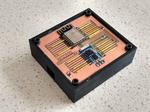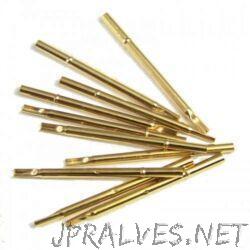Other

“This project allows the easy programming of the widely used ESP-12 module and its smaller brother the ESP-03 module. The ESP-12 module is commonly found on WeMos D1 and NodeMCU boards to name a few. Boards like …

A pogo pin or spring-loaded pin is a type of electrical connector mechanism that is used in many modern electronic applications and in the electronics testing industry. They are used for their improved durability over other electrical contacts, and the resilience of their electrical connection to mechanical shock and vibration. The name pogo pin comes from the pin's resemblance to a pogo stick – the integrated helical spring in the pin applies a constant normal force against the back of the mating receptacle or contact plate, counteracting any unwanted movement which might otherwise cause an intermittent connection. This helical spring makes pogo pins unique, since most other types of pin mechanisms use a cantilever spring or expansion sleeve. A complete connection path requires a mating receptacle for the pin to engage, which is termed a target or land. A pogo target consists of a flat or concave metal surface, which unlike the pins, has no moving parts. Targets may be separate components in the complete connector assembly, or in the case of printed circuit boards, simply a plated area of the board. Spring-loaded pins are precision parts fabricated with a turning and spinning process which does not require a mold, thus allowing the production of smaller quantities at a lower cost.

“This project allows the easy programming of the widely used ESP-12 module and its smaller brother the ESP-03 module. The ESP-12 module is commonly found on WeMos D1 and NodeMCU boards to name a few. Boards like …